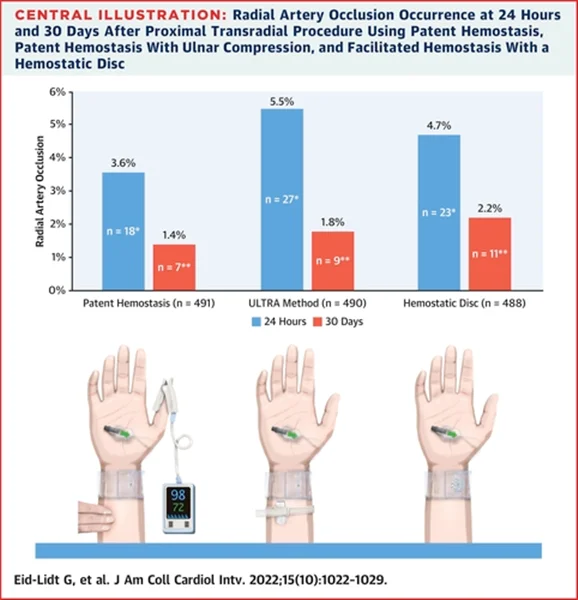Guering Eid-Lidt, Jesús Reyes-Carrera, Julio I. Farjat-Pasos, Carlos Aguila Bravo, Sara Nieto Rangel, Daniel Zazueta Salido, Norman Said Vega Servin, Maria Elena Soto-López, Jorge Gaspar
J Am Coll Cardiol Intv. 2022 May, 15 (10) 1022–1029
Abstract
Objectives
The main objective of this study was to compare the efficacy of 3 hemostatic methods for the prevention of early radial artery occlusion (RAO): standard patent hemostasis, patent hemostasis with ulnar compression or the ulnar artery transient compression facilitating radial artery patent hemostasis (ULTRA) method, and facilitated hemostasis with a hemostatic disc.
Background
There are no prospective randomized studies that compare early RAO rates with the 3 most used nonocclusive hemostatic methods.
Methods
This was a prospective, longitudinal, comparative, and randomized study. The final population analyzed was 1,469, and they were randomized into 3 groups: 491 patients in group 1 with standard patent hemostasis, 490 patients in group 2 with the ULTRA method, and 488 patients in group 3 with facilitated hemostasis with a hemostatic disc.
Results
The RAO rate at 24 hours of the total population analyzed was 4.6%. By hemostasis groups, it was 3.6% for patent hemostasis, 5.5% for the ULTRA method, and 4.7% for facilitated hemostasis with a hemostatic disc, with no statistical difference among the 3 groups (P = 0.387). At 30 days, the overall rate of RAO was 1.8%, and by groups, it was 1.4% for the patent hemostasis group, 1.8% for the ULTRA method group, and 2.2% for the facilitated hemostasis with a hemostatic disc group, respectively (P = 0.185).
Conclusions
The rates of RAO at 24 hours evaluated by plethysmography oximetry and confirmed by ultrasound among 3 current radial hemostasis methods (ie, patent hemostasis, the ULTRA method, and facilitated hemostasis with a hemostatic disc) are not different.


دیدگاه خود را بنویسید